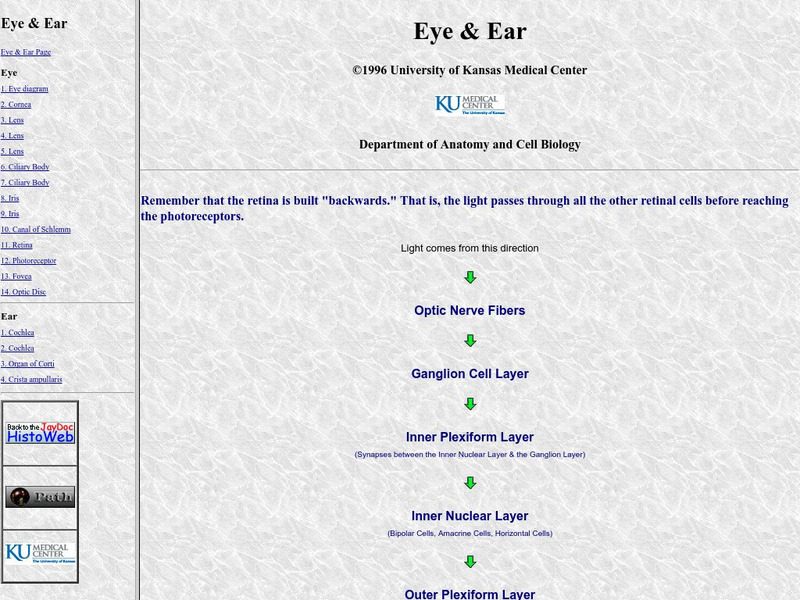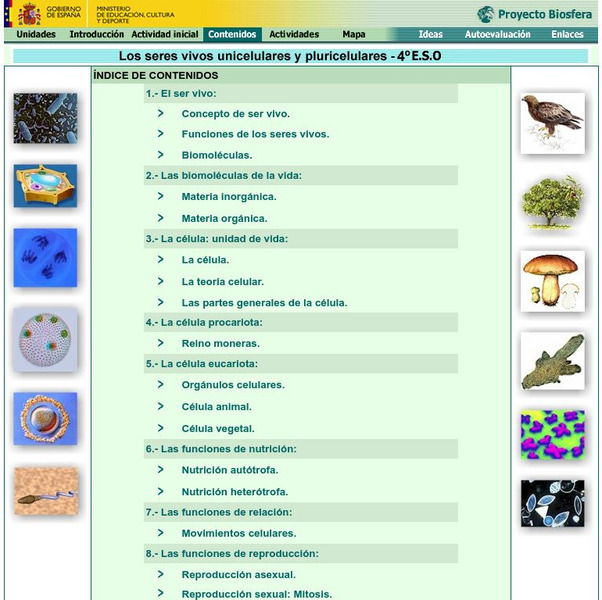Hi, what do you want to do?
University of Kansas Medical Center
University of Kansas Medical Center: Cell Structure
Discover microscopic images of various eukaryotic cells, both plant and animal.
Science Education Resource Center at Carleton College
Serc: Comparing the Simple Structure of Plant and Animal Cells
Students use guided scientific observation using a collection of models, visual material, and microscope slides to identify cell organelles. Then they demonstrate their understanding of the parts/characteristics of cells by identifying...
Estrella Mountain Community College
Online Biology Book: Flowering Plant Reproduction: Fertilization and Fruits
Microscopic images, detailed information, and illustrated diagrams help explain plant reproduction with a focus on fertilization.
Exploratorium
Exploratorium: Microscope Imaging Station: Blood Cells
This colorful site provides a gallery of blood cell photos. You can observe human white blood cells, human red blood cells, sheep red blood cells, and zebrafish red blood cells. As an added bonus, you can enlarge the red blood cell...
Exploratorium
Exploratorium: Microscope Imaging Station: Cell Motility
This interesting site explains how cells move and provides videos depicting the movement of various human and animal cells.
Exploratorium
Exploratorium: Microscope Imaging Station: Cell Development
This interesting site provides videos and photos of cells going through the process of cell division. Observe Zebrafish development and Sea urchin embryo cell division in video format.
National Health Museum
Access Excellence: Modeling Limits to Cell Size
Why can't cells continue to grow larger and larger to become giant cells, like a blob? Why are most cells microscopic in size? Find out answers to these questions through this "hands-on" activity that simulates the changing relationship...
Other
National Institute for Basic Biology: The Plant Organelles World
This web resource provides basic information about structure and function of plant organelles through a large interactive cell drawing, as well as many opportunities to explore further. Links lead the learner to several short movies of...
Colorado State University
Colorado State University: Gross and Microscopic Anatomy of the Stomach
Describes the human stomach in terms of its structural components.
Other
Wadsworth Center: Basophil
About as good as it gets for information on the basophil. Includes mention of the function, size, and number. Includes a micrograph of the cell.
Microscopy UK
Microscopy Uk: An Introduction to Microscopy
An introduction to the world of the microscope. Includes information about the instrument and the subjects you can study through the microscope.
University of Kansas Medical Center
University of Kansas Medical Center: Gastrointestinal System
Investigate the human gastrointestinal system with this extensive collection of microscopic specimens.
University of Kansas Medical Center
University of Kansas Medical Center: Eye & Ear
Understand the structure and function of the eye and ear cells by examining these microscopic tissue samples.
University of Kansas Medical Center
University of Kansas Medical Center: Bone
See several specimens of microscopic images of bone cells and tissue.
University of Kansas Medical Center
University of Kansas Medical Center: Female Reproductive System
Examine this collection of microscopic specimen images from the female reproductive system.
Science Buddies
Science Buddies: Career Profile: Medical & Clinical Laboratory Technician
Find out about the work done by the medical laboratory technician. It involves examining both body fluids and cells under the microscope or with specialized computer equipment, analyzing the results, and forwarding that information on to...
PBS
Pbs: Cancer Caught on Video
This interesting site presents microscopic videos of cancer growth and the formation of new blood vessels by the cancer cells so they can survive.
University of Kansas Medical Center
University of Kansas Medical Center: Endocrine System
Investigate this collection of microscopic samples of tissues and cells from the endocrine system.
Curated OER
Microscopic Photo of Green Stem Cells.
The buzz word "stem cells" are scientifically defined and the differences between stem cells and other cells explained in this "Everyday Mystery".
University of Missouri
Microbes in Action: Classroom Activities: Simple Staining of Microbes [Pdf]
With this simple stain, students can observe the shape of yeast and bacteria under the microscope. Lesson plan gives a lab procedure, teacher instructions, points for discussion, and additional activities. Lab does require the purchase...
National Institute of Educational Technologies and Teacher Training (Spain)
Ministerio De Educacion: Los Seres Vivos Unicelulares Y Pluricelulares
For this unit you will be introduced to the complexity of living things. It also reviews the kingdom of nature, differentiating between their main features from those who are microscopic unit-cellular to the multi-cellular visible to the...
University of Kansas Medical Center
University of Kansas Medical Center: Muscular System
Study several microscopic specimens taken from the three different types of muscle tissues: skeletal, smooth, and cardiac.
University of Kansas Medical Center
University of Kansas Medical Center: Vascular System
Learn about the three basic layers of the vascular system by examining cell and tissue specimens from those layers.
University of Kansas Medical Center
University of Kansas Medical Center: Basic Histopathology
These microscopic images of different cells and tissues from the human organs gives an idea of some the pathological processes that occur and the importance of histology.






















